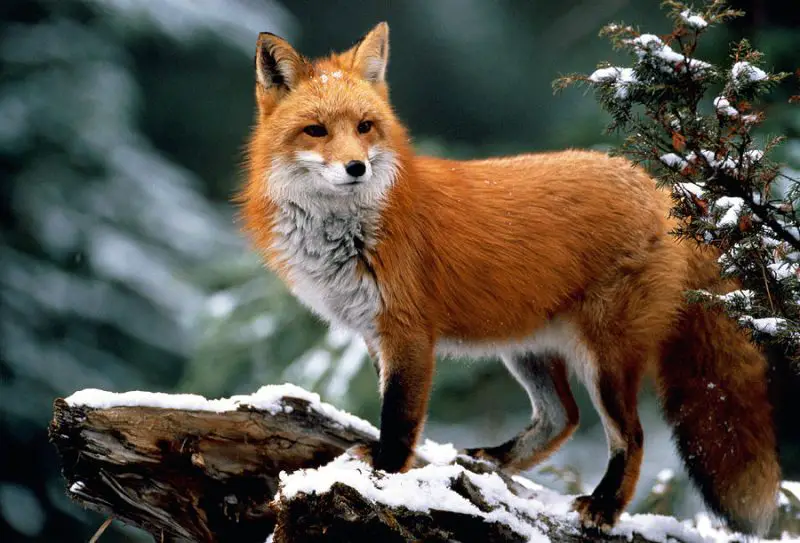Red foxes (Vulpes vulpes) are among the most intriguing and elusive mammals in North America. In Texas, their presence is often overlooked, even though they thrive in a variety of habitats across the state. Their striking reddish coat and bushy tail make them easily recognizable, while their intelligence and adaptability help them survive in diverse environments.
Despite being widespread, many Texans know little about the red fox’s behavior, hunting techniques, or how it interacts with the ecosystem. These clever predators are not just elusive; they play an important role in maintaining the balance of local wildlife populations.
This article delves into the mysteries of the red fox in Texas, exploring its physical characteristics, diet, reproductive habits, and distribution. By understanding these fascinating animals, readers can gain a deeper appreciation for one of the state’s most adaptable and secretive predators.
Physical Characteristics and Identification

The red fox is perhaps most recognized for its vivid reddish-orange fur, which is complemented by a white underbelly, black ear tips, and a distinctive bushy tail tipped with white. These color variations, however, can range from nearly golden to deep russet depending on genetics and environmental factors. Unlike other fox species, red foxes possess a slender, elongated snout and large, upright ears, which enhance their acute sense of hearing.
Size and body structure further aid in identification. Adult red foxes typically weigh between 8 to 15 pounds, though some individuals may exceed this range in areas with abundant prey. Their bodies measure approximately 18 to 35 inches in length, with tails adding an additional 12 to 21 inches. Males are generally larger than females, and their lean frames allow for agility and speed, essential traits for hunting and avoiding predators.
Observing their movement can also assist in identification. Red foxes are known for their graceful, almost feline-like gait, which includes silent, deliberate steps that make them exceptional hunters. In Texas, spotting a red fox often requires patience, as they are naturally cautious around humans and primarily nocturnal or crepuscular, active during dawn and dusk.
Behavior and Social Structure
Red foxes are solitary creatures for most of the year, but they exhibit complex social behaviors during the breeding season. Unlike wolves, which live in packs, red foxes maintain territories that they defend vigorously through scent markings and vocalizations. Their communication includes a range of barks, yips, and screeches, each serving a specific purpose from warning intruders to signaling alarm.
These foxes are highly adaptable and opportunistic. In urban and suburban areas, they can alter their behavior to avoid humans, often scavenging garbage or preying on small domestic animals. In more rural or wild settings, red foxes demonstrate remarkable hunting intelligence, sometimes manipulating the environment to flush out prey or hunting cooperatively with their mate when rearing young.
Despite their solitary nature, family bonds are strong during the breeding season. Cubs remain with their mother for up to six months, learning hunting and survival skills before dispersing to establish their own territories. Observations in Texas have shown that siblings occasionally form temporary alliances when food is scarce, further highlighting their social complexity.
Hunting and Diet
Red foxes are opportunistic carnivores, and their diet reflects the diversity of Texas ecosystems. Small mammals such as rabbits, mice, and voles form the bulk of their diet, though birds, reptiles, and amphibians are also consumed. In some areas, red foxes may take advantage of human-related food sources, including discarded food or livestock feed, demonstrating their flexibility in survival strategies.
Hunting techniques are diverse and adapted to local conditions. Foxes use their acute hearing to detect prey movements under grass, snow, or leaf litter. Once located, they execute a remarkable pounce, leaping and landing precisely to capture the unsuspecting animal. Studies have shown that red foxes adjust their hunting techniques seasonally, focusing more on insects and fruits during warmer months when small mammals are less abundant.
This dietary flexibility contributes to their successful establishment throughout Texas, from densely forested regions to open prairies and even suburban neighborhoods. Their ability to exploit various food sources allows them to survive where other predators might struggle, making them highly resilient members of the ecosystem.
Reproduction and Life Cycle
Breeding season for red foxes in Texas generally occurs from late January through March. During this time, males actively seek out females, sometimes traveling significant distances to find a mate. Courtship involves vocal displays, scent marking, and a series of playful interactions designed to strengthen pair bonds. Once a pair forms, they maintain a temporary territory together, often returning to the same den for successive years.
Dens are carefully constructed or selected, often in burrows abandoned by other animals, beneath dense vegetation, or along riverbanks and wooded edges. The female typically gives birth to a litter of three to seven cubs after a gestation period of approximately 51 days. Cubs are born blind and helpless, relying entirely on maternal care during the early weeks.
Both parents play a role in nurturing the young. While the mother nurses and protects the cubs, the father hunts and provides food. As cubs grow, they are gradually introduced to solid foods, learning hunting skills through observation and practice. By late summer, young foxes begin dispersing to establish their own territories, completing the life cycle.
Distribution Across Texas
Red foxes are remarkably widespread in Texas, though their distribution varies according to habitat suitability. They are most commonly found in regions with a mix of forests, grasslands, and agricultural lands, which provide both cover and abundant prey. Eastern Texas, with its piney woods and mixed hardwood forests, supports dense populations, while the western plains and desert regions host smaller, more dispersed populations.
Urban and suburban areas also host red foxes, as they adapt to human-altered landscapes. They are frequently spotted along city edges, golf courses, and even residential neighborhoods. Despite human presence, red foxes often remain hidden during the day, emerging primarily at dawn or dusk to hunt or patrol their territory.
Conservation efforts have not identified red foxes as threatened in Texas, largely due to their adaptability. However, habitat fragmentation and human-wildlife conflicts, particularly with agriculture, pose localized challenges. Understanding their distribution and habits is essential for coexisting with these enigmatic predators.
Optimal Times and Locations for Observation
For wildlife enthusiasts seeking to observe red foxes in Texas, timing and location are critical. The best times are typically during the cooler months of late fall through early spring, when foxes are more active in search of food. Dawn and dusk are the optimal hours, as red foxes are crepuscular and avoid the heat and human activity of midday.
Habitat choice is equally important. Forest edges, riparian corridors, and grasslands adjacent to wooded areas provide cover and abundant prey. Observers have had notable success spotting red foxes near hunting blinds, nature reserves, and even rural backyards where human activity is minimal during peak activity hours. Patience is essential, as foxes are highly alert and often retreat at the slightest disturbance.
While spotting a red fox can be challenging, signs such as tracks, scat, and partially cached prey can provide indirect evidence of their presence. Listening for vocalizations, particularly high-pitched barks or screams during the breeding season, also increases the likelihood of detecting these elusive mammals.
Ecological Role and Importance
Red foxes play a crucial role in Texas ecosystems as both predators and scavengers. By controlling populations of rodents and other small mammals, they help maintain balance in local food webs. Their scavenging behavior also aids in nutrient recycling, reducing disease transmission by consuming carrion.
These foxes influence prey behavior, indirectly shaping plant communities. For example, by preying on herbivorous rodents, they can reduce overgrazing and allow vegetation to flourish. Their presence also benefits other predators by creating competition that promotes ecological diversity.
Additionally, red foxes serve as bioindicators, reflecting the health of ecosystems in which they live. Populations that thrive indicate abundant prey and intact habitats, while declining numbers may signal environmental stressors such as habitat loss or pollution. Understanding the role of red foxes in Texas helps highlight their importance beyond mere observation, emphasizing their contribution to ecological balance.
Misconceptions and Lesser-Known Facts
Despite their widespread presence, red foxes are often misunderstood. Many people assume they are primarily nocturnal, but red foxes are highly adaptable and may be seen during the day, particularly in low-disturbance areas. Others mistake them for domestic dogs or coyotes, not recognizing their unique facial features and bushy tails.
Texas foxes exhibit remarkable adaptability to human-altered environments, sometimes surprising residents with their presence in urban parks or suburban streets. Unlike larger predators, red foxes rarely pose a threat to humans, preferring to avoid confrontation. Their cunning nature, diverse diet, and complex social behaviors make them one of the most fascinating mammals in the state, yet many of their behaviors remain little understood by the general public.
Research continues to reveal hidden aspects of their lives, including sophisticated hunting strategies, seasonal behavioral changes, and interactions with other wildlife. For naturalists and wildlife enthusiasts, uncovering these mysteries provides a deeper appreciation for the red fox and the ecosystems it inhabits.
Conclusion
The red fox in Texas is a master of adaptability, blending striking physical beauty with intelligence and resourcefulness. From their vivid reddish coats to their complex social structures, red foxes exemplify the intricacies of wildlife behavior. Understanding their distribution, diet, reproduction, and ecological role helps dispel myths and highlights their importance in Texas ecosystems.
For those willing to venture into forests, prairies, or quiet suburban edges during dawn or dusk, the red fox offers an unforgettable glimpse into the hidden world of a skilled predator. As more people learn to appreciate their presence, the mysteries of the red fox in Texas continue to inspire curiosity, respect, and a deeper connection to the natural world.
FAQs About Red Foxes in Texas
What do red foxes in Texas eat?
Red foxes in Texas are opportunistic carnivores and omnivores. Their diet primarily includes small mammals such as rabbits, mice, and voles, but they also consume birds, reptiles, amphibians, insects, and fruits. In suburban areas, they may scavenge human food or feed on livestock feed if available.
How can I identify a red fox in Texas?
Red foxes are identified by their reddish-orange fur, bushy tail with a white tip, black ear tips, and slender snout. They have a graceful, cat-like gait and are smaller than coyotes, usually weighing between 8 to 15 pounds with a body length of 18 to 35 inches.
Where in Texas are red foxes most commonly found?
Red foxes are widespread across Texas but are most common in areas with a mix of forests, grasslands, and agricultural lands. Eastern Texas forests, prairies, and suburban edges are frequent habitats, while western plains host smaller, more dispersed populations.
When are red foxes most active?
Red foxes are primarily crepuscular, being most active during dawn and dusk. However, they can occasionally be seen during the day, especially in areas with minimal human disturbance. Activity may also increase during cooler months when hunting conditions are favorable.
How do red foxes reproduce?
Breeding season in Texas occurs from late January through March. Mating pairs establish temporary territories, and the female gives birth to 3–7 cubs after a gestation period of about 51 days. Both parents contribute to raising the young, teaching them hunting and survival skills.
Are red foxes dangerous to humans or pets?
Red foxes are generally shy and avoid human contact. They rarely pose a threat to humans. Small pets may be at risk in rare cases, especially if unattended outdoors, but attacks are uncommon. Red foxes primarily hunt small wildlife and scavenge for food.
How can I spot a red fox in the wild?
The best way to spot a red fox in Texas is to visit forest edges, prairies, or suburban outskirts during dawn or dusk. Look for indirect signs such as tracks, scat, or partially cached prey. Listening for high-pitched barks or screams, especially during breeding season, can also indicate their presence.
What ecological role do red foxes play in Texas?
Red foxes help control populations of rodents and small mammals, reducing overgrazing and promoting healthy plant communities. As scavengers, they aid nutrient recycling, and their presence serves as a bioindicator of ecosystem health.






